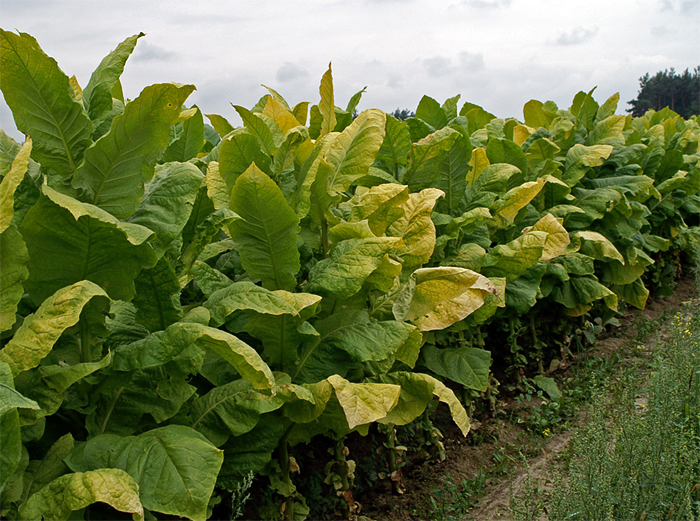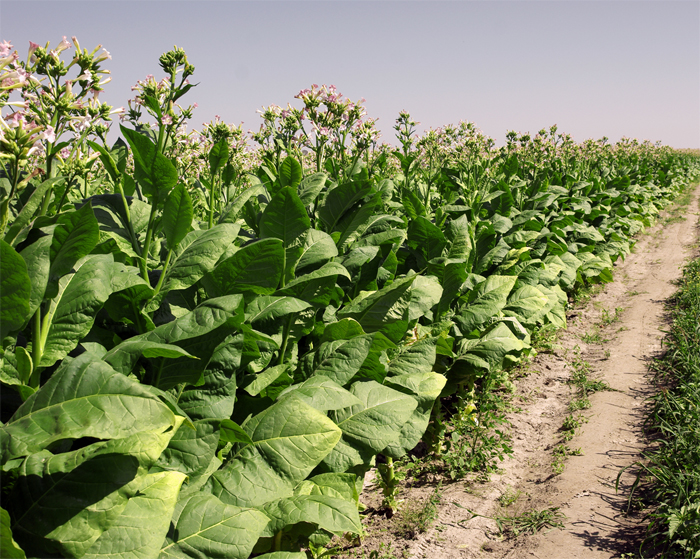| |
|
|
Tobacco breeding of new tobacco cultivars with improved quality
and resistance to diseases by means of conventional, biotechnology
and cytogenetics-based methods
With the agricultural institutes in Pulawy, breeding of tobacco
varieties has been a tradition for nearly a century. Located very
close to the heartland of Poland's tobacco production, IUNG-PIB
and its predecessors were very actively engaged in giving scientific
support to the community of tobacco farmers, providing them with
expert advice on many aspects of tobacco farming but also giving
them new varieties. In the sixties and in the seventies of the last
century tobacco breeding became one of the trademarks of this institute,
as new disease-resistant varieties developed here saved tobacco
in Poland from being annihilated by onslaughts of devastating plagues
such as PVY and blue mould. They also helped tobacco production
in Poland grow into a flourishing enterprise with more than 50000
hectares of land under tobacco and an annual output of ca. 100000
tons of cured tobacco leaves, values reached at the peak of tobacco
production in Poland in the late seventies and early eighties.
At present, in the wake of economic changes and incessant campaigns
against tobacco, the production of this crop in Poland has scaled
down considerably (to ca. 17000 ha) but it still remains a viable
option, frequently the only viable option, for many Polish farmers.
Surprisingly enough, tobacco in Poland has suffered less than in
many other European countries, otherwise much better naturally suited
to grow it. Indeed, in these times of adversities Poland, the northern-most
tobacco-growing country, not only did not disappear from the map
of tobacco production but actually became the third-largest tobacco
producer in Europe. This very fact alone bears witness to the ability
and resilience of Polish tobacco farmers. It is also a testimony
to the proficiency of Polish tobacco scientists and agronomists,
including those engaged in tobacco improvement programmes. One should
bear in mind that tobacco production in Poland, a country of austere
and non-typical tobacco growing conditions, has to rely mainly on
domestically-bred cultivars.
VRG
- black root rot resistant varieties
PVY resistant varieties (conventional,
GMO)
TSWV resistant varieties
VRG - black root rot resistant varieties
The on-going tobacco breeding programme at IUNG focuses mainly on
flue-cured (Virginia) tobacco but considerable attention is also
given to Burley and dark-air cured tobacco. In the last decade,
an array of new Virginia varieties have been developed and released
to farmers. What those varieties have in common is that all of them
are cytoplasmically sterile hybrids, and all have resistance to
black root rot caused by the ubiquitous soil fungus Chalara elegans.
The resistance to black root combined with improved curing and leaf
quality characteristics was the main factor behind the success of
the new varieties with farmers and tobacco leaf merchants in Poland.
Designed as potential alternatives to the old-line variety Wi¶lica,
increasingly preyed upon by black root rot, within a few years the
new varieties all but replaced the old cultivar that had dominated
the Polish flue-cured tobacco market for many years.
VRG 1 - a variety that thrives best on moderately fertile soils.
Readily responds to high level of native nutrients in the soil and
to increased fertilization with abundant if not over-luxurious growth.
Curability of VRG 1 is very good but it tends to produce leaves
with thin body, especially when grown at high plant densities on
rich soils.
VRG 2 - a variety for moderately rich soils but with nutritional
requirements slightly higher than those of VRG 1. Prefers soils
of good tilth with a fair content of coarse fractions. Produces
medium heavy-bodied leaves of good curability. Given good management,
performs better than the traditional Wi¶lica even in the black root-free
environment. VRG 2 is the variety of choice with the major leaf
merchants operating in the Polish market as its smoking characteristics
resemble most closely those of Wi¶lica.
VRG 3 - prefers soils in good tilth with good water retention capabilities.
Because of a relatively shallow root and weak root system VRG 3
is sensitive to periodic soil water deficits (droughts) and is therefore
not a good choice for light sandy soils especially those with defective
water relations. VRG 3 gives moderately high yields and its leaves
tend to mature slowly, especially in cool weather. The cured leaves
are distinguished for thick body and open grainy texture. Because
of variable yields, VRG 3 is the least popular of the new varieties.
VRG 4 - similar to VRG 3 in all major agronomic characteristics
except the yields. VRG 4 is a good yielder, better than VRG 2, and
readily produces heavy bodied, open-textured cured leaves provided
they are harvested at full ripeness. Like VRG 3, in cool summers
it matures slowly and is therefore not suitable for northern regions
of the country.
VRG 5 TL - the most recent addition to the line of new black root
rot resistant varieties and also the most innovative one. Unlike
the previous four varieties which are conventional simple F1 hybrids,
VRG 5 TL is a three-line hybrid which means that one of its parents
is also a hybrid rather than an inbred line. Unlike the other varieties,
which are variations of the relatively slow growing, medium-late-flowering
type of Wi¶lica, VRG 5 TL is a fast growing, early flowering variety
that thrives on many kinds of soils. It is tolerant of moderate
excess of water but should be avoided on soils prone to drought,
especially in the spring. If managed properly, VRG 5 TL produces
high yields of well-cured, open-textured and heavy-bodied leaves.
It seems to be a very successful newcomer to the flue-cured market
in Poland, with the first on-farm tests performed only two years
ago and seed orders for the coming 2011 season exceeding 3 kg (enough
to plant ca. 450 ha) and limited with the availability of seeds.
Tobacco breeding in Poland can be regarded as part of a larger tobacco
improvement effort conducted in several European countries such
as Germany, France, Hungary, Greece, Croatia, Spain and some others.
There is an idea to bring this effort together under the auspices
of AERET (Association Europeenne pour la Recherche et l'Experimentation
Tabacole), a newly established European organization of tobacco
growers and agronomists with the purpose to promote information-sharing
on tobacco leaf production and to organize common research in tobacco.
Within the framework of AERET, IUNG-PIB takes part in building the
network of joint tobacco variety experiments and participates in
the compiling of the European catalogue of tobacco varieties.

VRG 2 - the most popular in the line of new black root rot resistant
hybrid varieties of flue-cured tobacco developed at IUNG-PIB

Field of VRG 4 - black root rot resistant flue-cured variety from
Pulawy

Field of VRG 5TL - first three-line hybrid of flue-cured tobacco
resistant to black root rot
PVY resistant varieties (conventional, GMO)
TSWV resistant varieties
As a result of breeding researches the PW-DH tobacco lines with
a high level of TSWV resistance were obtained. A single-dominant
model of resistance was found in these lines and they are a valuable
initial breeding material in developing acceptable cultivars of
a good quality and with TSWV resistance.
|
|
